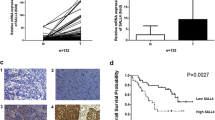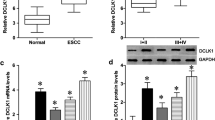Abstract
Background
Cancer stem cells are regarded as the origin of tumors that can proliferate, relapse, and metastasize. Nanog, with its capacity to maintain the pluripotency and regulate proliferation and prevent differentiation, is one of the most important core markers of cancer stem cells. Studying the role of Nanog in esophageal squamous cell carcinoma (ESCC), therefore, has important implications.
Methods
In the present study, we first detected the expression of Nanog in the ESCC and cell lines by RT-PCR, immunofluorescence, and immunohistochemisty. Then, we used small interfering RNA (siRNA) to block Nanog expression while evaluating the effect of Nanog siRNA on cell apoptosis and the combined effects with Cisplatin in ESCC cell lines.
Results
The results showed that both mRNA and protein-level Nanog are overexpressed in ESCC tissues compared with their normal counterparts, and the increased occurrence of Nanog expression was positively correlated with TNM stages and histopathological differentiation of ESCC patients (p < 0.01). At the same time, Nanog siRNA efficiently decreased Nanog expression and induced cell apoptosis. Treatment with Nanog siRNA in combination with Cisplatin, therefore, enhanced chemosensitivity.
Conclusion
The present study’s results suggest that detecting Nanog might be helpful for diagnosing ESCC, and Nanog siRNA combined with Cisplatin may be a feasible strategy to enhance the sensitivity of chemotherapy in patients with ESCC.






Similar content being viewed by others
References
Ben-Porath I, Thomson MW, Carey VJ et al (2008) An embryonic stem cell-like gene expression signature in poorly differentiated aggressive human tumors. Nat Genet 40:499–507
Bojko P, Scharifi M, Stössel K et al (2002) Comparison of processing four and five times the patients’ blood volume during peripheral blood stem cell collection and analysis of CD34+38– and CD34+49d+ subsets during apheresis. J Cancer Res Clin Oncol 128(1):19–28
Bourguignon LY, Peyrollier K, Xia W, Gilad E (2008) Hyaluronan-CD44 interaction activates stem cell marker Nanog, Stat-3-mediated MDR1 gene expression, and ankyrin-regulated multidrug efflux in breast and ovarian tumor cells. J Biol Chem 283:17635–17651
Chang DF, Tsai SC, Wang XC et al (2009) Molecular characterization of the human Nanog protein. Stem Cells 27:812–821
Chen R, Xiao W, Li D et al (2011) Combination of simvastatin and imatinib sensitizes the CD34+ cells in K562 to cell death. Med Oncol 28:528–531
Chiou SH, Yu CC, Huang CY (2008) Positive correlations of Oct-4 and Nanog in oral cancer stem-like cells and high-grade oral squamous cell carcinoma. Clin Cancer Res 14:4085–4095
Clarke MF, Dick JE, Dirks PB et al (2006) Cancer stem cells N perspectives on current status and future directions: AACR workshop on cancer stem cells. Cancer Res 66:9339–9344
Darr H, Mayshar Y, Benvenisty N (2006) Overexpression of NANOG in human ES cells enables feeder-free growth while inducing primitive ectoderm features. Development 133:1193–1201
Dennis N (2002) Common control for cancer, stem cells. Science 298:1869–1875
Ezeh UI, Turek PJ, Reijo RA et al (2005) Human embryonic stem cell genes OCT4, NANOG, STELLAR, and GDF3 are expressed in both seminoma and breast carcinoma. Am Cancer Soc 104:2255–2266
Freberg CT, Dahl JA, Timoskainen S et al (2007) Epigenetic reprogramming of OCT4 and NANOG regulatory regions by embryonal carcinoma cell extract. Mol Biol Cell 18:1543–1553
Fujii H, Honoki K, Tsujiuchi T et al (2009) Sphem forming stem-like cell populations with drug resistance in human sarcoma cell lines. Int J Oncol 34:1381–1386
Gu G, Yuan J, Wills M et al (2007) Prostate cancer cells with stem cell characteristics reconstitute the original human tumor in vivo. Cancer Res 67:4807–4815
Hart AH, Hartley L, Ibrahim M et al (2004) Identification, cloning and expression analysis of the pluripotency promoting Nanog genes in mouse and human. Dev Dyn 230:187–198
Hoei-Hansen CE, Kraggerud SM, Abeler VM (2007) Ovarian dysgerminomas are characterised by frequent KIT mutations and abundant expression of pluripotency markers. Mol Cancer 2:6–12
Huang D, Gao Q, Guo L et al (2009) Isolation and identification of cancer stem-like cells in esophageal carcinoma cell lines. Stem Cells 18:465–473
Jordan CT, Guzman ML, Noble M (2006) Cancer stem cells. N Engl J Med 355:1253–1261
Lee TK, Castilho A, Cheung VC, et al (2011) CD24+ liver tumor-initiating cells drive self-renewal and tumor initiation through STAT3-mediated NANOG regulation.Cell Stem Cell 9(1):50–63
Lin T, Ding YQ, Li JM (2011) Overexpression of Nanog protein is associated with poor prognosis in gastric adenocarcinoma. Med Oncol. [Epub ahead of print]
Liu SJ, Cai ZW, Liu YJ et al (2004) Role of nucleostemin in growth regulation of gastric cancer, liver cancer and other malignancies. World J Gastroenterol 10:1246–1249
Mitsui K, Tokuzawa Y, Itoh H, Segawa K et al (2003) The homeoprotein Nanog is required for maintenance of pluripotency in mouse epiblast and ES cells. Cell 113:631–642
Pan G, Thomson JA (2007) Nanog and transcriptional networks in embryonic stem cell pluripotency. Cell Res 17:42–49
Ratajczak MZ, Machalinski B, Wojakowski W et al (2007) A hypothesis for an embryonic origin of pluripotent Oct-4(+) stem cells in adult bone marrow and other tissues. Leukemia 21:860–867
Santagata S, Ligon KL, Hornick JL (2007) Embryonic stem cell transcription factor signatures in the diagnosis of primary and metastatic germ cell tumors. Am J Surg Pathol 31:836–845
Seigel GM, Hackam AS, Ganguly A et al (2007) Human embryonic and neuronal stem cell markers in retinoblastoma. Mol Vis 13:823–832
Singh SK, Clarke ID, Terasaki M et al (2003) Identification of a cancer stem cell in human brain tumors. Cancer Res 63:5821–5828
Siu MK, Wong ES, Chan HY et al (2008) Overexpression of NANOG in gestational trophoblastic diseases. Am J Pathol 173:1165–1172
Stoner GD, Gupta A (2001) Etiology and chemoprevention of esophageal squamous cell carcinoma. Carcinogenesis 22:1737–1746
Tiezzi DG, Valejo FA, Marana HR, et al (2011) CD44(+)/CD24 (−) cells and lymph node metastasis in stage I and II invasive ductal carcinoma of the breast. Med Oncol. [Epub ahead of print]
Trosko JE (2006) From adult stem cells to cancer stem cells: Oct-4 gene, cell–cell communication, and hormones during tumor promotion. Ann N Y Acad Sci 1089:36–58
Wang SH, Tsai MS, Chiang MF et al (2003) A novel NK-type homeobox gene, ENK (early embryo specific NK), preferentially expressed in embryonic stem cells. Gene Expr Patterns 3:99–103
Wang Q, He W, Lu C, Wang Z et al (2009) Oct3/4 and Sox2 are significantly associated with an unfavorable clinical outcome in human esophageal squamous cell carcinoma. Anticancer Res 29:1233–1241
Yasuda SY, Tsuneyoshi N, Sumi T et al (2006) NANOG maintains self-renewal of primate ES cells in the absence of a feeder layer. Genes Cells 11:1115–1123
Ye F, Zhou C, Cheng Q et al (2008) Stem-cell-abundant proteins Nanog, Nucleostemin and Musashi1 are highly expressed in malignant cervical epithelial cells. BMC Cancer 8:108–113
Zhang S, Ding F, Luo A et al (2007) XIAP is highly expressed in esophageal cancer and its downregulation by RNAi sensitizes esophageal carcinoma cell lines to chemotherapeutics. Cancer Biol Ther 6:973–980
Zou X, Lu F, Zhang S (2002) Characteristics of esophageal cancer mortality in China in 1990–1992. Bull Chin Cancer 11:446–449
Acknowledgments
This paper was supported by Grants no. 2011225015 from the Science and Technology Project Foundation of Science and Technology Department of Liaoning Province of China, and No. Y2011Z001 from the Young Foundation of Liaoning Medical University of China, and No. Fy2011-01 from the Young Foundation of the First Affiliated Hospital of Liaoning Medical University of China.
Conflict of interest
The authors declare that they have no competing interests.
Author information
Authors and Affiliations
Corresponding author
Rights and permissions
About this article
Cite this article
Du, Y., Shi, L., Wang, T. et al. Nanog siRNA plus Cisplatin may enhance the sensitivity of chemotherapy in esophageal cancer. J Cancer Res Clin Oncol 138, 1759–1767 (2012). https://doi.org/10.1007/s00432-012-1253-8
Received:
Accepted:
Published:
Issue Date:
DOI: https://doi.org/10.1007/s00432-012-1253-8




